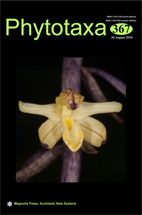Abstract
In Paepalanthus ser. Dimeri, one of the few groups of Eriocaulaceae with dimerous flowers, the poorly understood circumscription of Paepalanthus elongatus and its numerous infraspecific taxa challenge the delimitation of the remaining taxa and distorts the group’s actual diversity. In order to clarify the taxonomy of the group in central Brazil, nomenclatural and taxonomic changes are proposed. Paepalanthus cassiae is described based on specimens usually misidentified as P. elongatus, as well as specimens collected on recent field trips. The new species is easily distinguished from P. elongatus by its smaller habit, dark castaneous leaf sheath, and golden to pale straw-colored involucral bracts, twice as long as the floral disc. Paepalanthus longibracteatus and P. niger are raised to species status based on P. elongatus varieties briefly described by Harold Moldenke. Detailed descriptions are provided for these species. The three species detailed occur in the vicinities of the recently extended Chapada dos Veadeiros National Park. Details of the species’ etymology, distribution, biology, conservation status, and morphological variation, along with illustrative photographs, are provided. Paepalanthus elongatus var. glabrescens is treated as a new synonym of P. elongatus var. elongatus.
References
<p class="Reference">Andrade, M.J.G., Giulietti, A.M., Rapini, A., Queiroz, L.P., Conceição, A.S., Almeida, P.R.M. & van den Berg, C. (2010) A comphrehensive molecular phylogenetic analysis of Eriocaulaceae: evidence from nuclear (ITS) and plastid (psbA-trnH and trnL-trnF) DNA sequences. <em>Taxon</em> 59: 379–388.</p><p class="Reference">Bongard, M. (1831) Essai monographique sur les espèces d’Ériocaulon du Brésil. <em>Mémoirs Academie Imperial Sciences St-Pétersbourg, Série 6, Sciences Mathematiquè</em> 1: 601–655.</p><p class="Reference">Brazilian Ministry of the Environment (2017) Ampliação, limite geográfico, Parque Nacional, Chapada dos Veadeiros, Municipios, Alto Paraíso de Goiás, Cavalcante, Nova Roma, Teresina de Goiás, São João D’Aliança, Estado de Goiás (GO). Available from: <a href="http://pesquisa.in.gov.br/imprensa/jsp/visualiza/index.jsp?data=06/06/2017&jornal=1&pagina=10&totalArquivos=216">http://pesquisa.in.gov.br/imprensa/jsp/visualiza/index.jsp?data=06/06/2017&jornal=1&pagina=10&totalArquivos=216</a> (accessed 22 August 2018)</p><p class="Reference">IUCN Standards Petitions Sub-committee (2011) <em>Guidelines for using the IUCN Red List Categories and Criteria, Version 9.0.</em> Available from: http://www.iucn.org (accessed 28 March 2018)</p><p class="Reference">Koernicke, F. (1863) Eriocaulaceae. <em>In</em>: Martius, C.F.P. & Eichler, A.W. (Eds.) <em>Flora brasiliensis</em> 3(1). Royal Typography, Munich, pp. 273–508.</p><p class="Reference"> https://doi.org/10.5962/bhl.title.454</p><p class="Reference">Kuntze, O. (1891) Eriocaulaceae. <em>In</em>: <em>Revisio Generum Plantarum</em> 2. Arthur Felix, Leipzig, pp. 745–746.</p><p class="Reference"> https://doi.org/10.5962/bhl.title.327</p><p class="Reference">Luetzelburg, P. (1923)<em> Estudo botanico do Nordeste</em>, vol. 1. Ministério de viação e obras públicas, Rio de Janeiro, 126 pp.</p><p class="Reference">Martius, K.F.P. (1834) Eriocaulaceae. <em>Anales des Sciences Naturelles</em>,<em> Botanique</em> 2: 25–43.</p><p class="Reference">Moldenke, H.N. (1972) Four novelties from Brazil. <em>Phytologia</em> 24: 498–499.</p><p class="Reference">Moldenke, H.N. (1974) Notes on new and noteworthy plants LXXII. <em>Phytologia</em> 29: 192–193.</p><p class="Reference"> https://doi.org/10.5962/bhl.part.13103</p><p class="Reference">Moldenke, H.N. (1979) Notes on new and noteworthy plants CXXIII. <em>Phytologia</em> 43: 196–197.</p><p class="Reference">Radford, A.E., Dickson, W.C., Massey, J.R. & Bell, C.R. (1974) <em>Vascular plant systematics. </em>Harper & Row Pub, New York, 891 pp.</p><p class="Reference">Ruhland, W. (1903) Eriocaulaceae. <em>In</em>: Engler, A. (Ed.) <em>Das Pflanzenreich. Regni vegetabilis conspectus</em> 4 heft 30. Wilhelm Engelmann, Leipzig, pp. 1–294.</p><p class="Reference">Silva, A.L., Trovó, M. & Coan. A.I. (2016) Floral development and vascularization help to explain meristem evolution in <em>Paepalanthus</em> (Eriocaulaceae, Poales). <em>PeerJ</em> 4: e2811.</p><p class="Reference"> https://doi.org/10.7717/peerj.2811</p><p class="Reference">Silveira, A.A. (1928) <em>Floralia montium</em>, vol. 1. Imprensa Official, Belo Horizonte, 262 pp.</p><p class="Reference">Stuessy, T.F. (1990) <em>Plant taxonomy, the systematic evaluation of comparative data</em>. Columbia University, Press New York, 562 pp.</p><p class="Reference">Stützel, T. & Trovó, M. (2013) Inflorescences in Eriocaulaceae: taxonomic relevance and practical implications. <em>Annals of Botany</em> 112: 1505–1522.</p><p class="Reference"> https://doi.org/10.1093/aob/mct234</p><p class="Reference">Thiers, B. (continuously updated) Index Herbariorum: <em>A global directory of public herbaria and associated staff. New York Botanical Garden’s Virtual Herbarium</em>. Available from: http://sweetgum.nybg.org/ih/ (accessed 23 February 2017)</p><p class="Reference">Trovó, M. & Sano, P.T. (2010) Taxonomic survey of <em>Paepalanthus</em> section <em>Diphyomene</em> (Eriocaulaceae). <em>Phytotaxa</em> 14: 49–55.</p><p class="Reference"> https://doi.org/10.11646/phytotaxa.14.1.4</p><p class="Reference">Trovó, M. & Sano, P.T. (2014) <em>Paepalanthus conjunctus</em>, a new species of <em>Paepalanthus</em> sect. <em>Diphyomene</em> (Eriocaulaceae) from Central Brazil. <em>Phytotaxa</em> 178 (1): 53–56.</p><p class="Reference"> https://doi.org/10.11646/phytotaxa.178.1.7</p><p class="Reference">Trovó, M., Echternacht, L.A. & Sano, P.T. (2013). Distribution and conservation of<em> Paepalanthus </em>Mart. sect.<em> Diphyomene</em> Ruhland (Eriocaulaceae) in Neotropical savannas. <em>Adansonia</em> 35: 195–206.</p><p class="Reference"> https://doi.org/10.5252/a2013n2a2</p><p class="Reference">Trovó, M., Silva, A.L. & Coan, A.I. (2015). <em>Paepalanthus echinoides</em> (Eriocaulaceae), a new species from central Brazil with notes on leaf and scape anatomy. <em>Phytotaxa</em> 231 (1): 81–88.</p><p class="Reference"> https://doi.org/10.11646/phytotaxa.231.1.8</p><p class="Reference">Trovó, M., Silva, A.L. & Coan, A.I. (2017). <em>Paepalanthus modestus</em> (Eriocaulaceae), a new dimerous species from Goiás, Brazil, with notes on leaf and scape anatomy<em>.</em> <em>Phytotaxa</em> 316 (3): 271–278.</p><p class="Reference"> https://doi.org/10.11646/phytotaxa.316.3.6</p><p>Weberling, F. (1989) <em>Morphology of flowers and inflorescences.</em> Cambridge University Press, Cambridge, 423 pp.</p>

